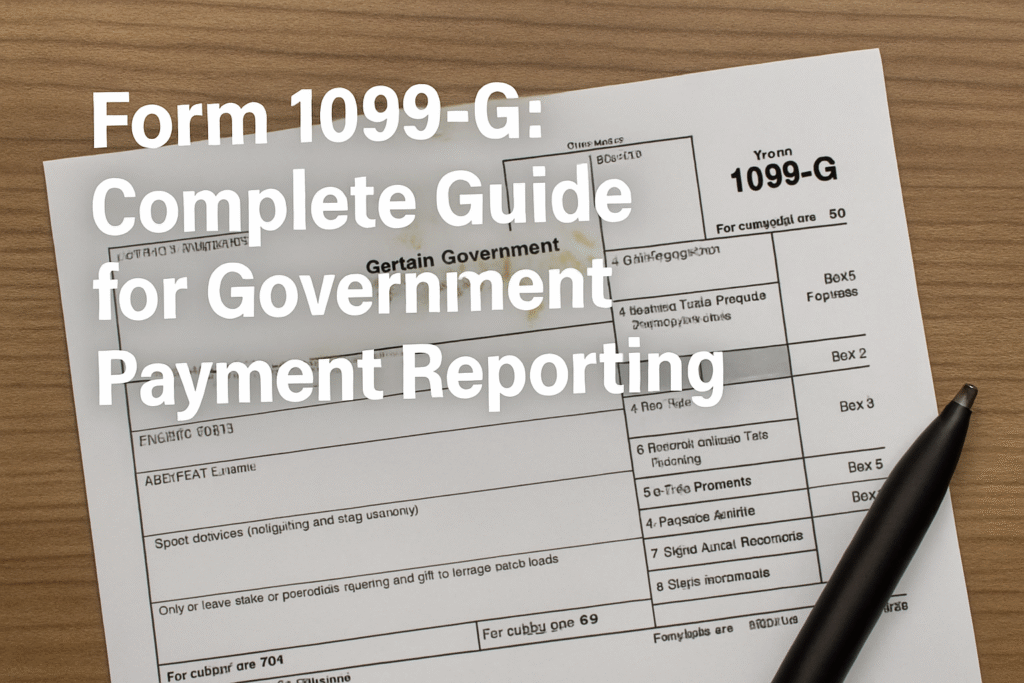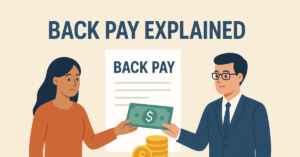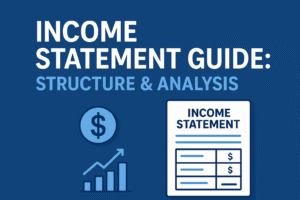Form 1099-G, officially titled “Certain Government Payments,” is an IRS information return used to report payments made by federal, state, or local governments to individuals or businesses. While it’s commonly associated with unemployment compensation, its scope extends to various government disbursements that may affect a recipient’s tax return.
This guide explores what Form 1099-G is, the types of payments it covers, how it differs from Forms 1099-MISC and 1099-NEC, filing instructions, deadlines, penalties, and what recipients should do when they receive one.
What is Form 1099-G?
IRS Form 1099-G is used by government agencies to report certain payments made to individuals and businesses during the tax year. It is primarily issued to:
- Taxpayers who received unemployment compensation
- Taxpayers who received state or local income tax refunds or credits
- Entities that received agricultural payments
- Taxpayers who benefited from re-employment trade adjustment assistance (RTAA) payments, and
- Other recipients of reportable government disbursements
The purpose of Form 1099-G is to inform recipients and the IRS about income that may be taxable, depending on the circumstances.
What Are the Payments Covered by Form 1099-G?
Form 1099-G includes several types of government payments. Here’s an elaboration on the key categories:
1. Unemployment Compensation (Box 1)
This is the most common reason individuals receive Form 1099-G. Any unemployment benefits received from state or federal agencies are reported here and are fully taxable at the federal level unless excluded by specific laws (e.g., temporary exclusions during COVID-19 under the American Rescue Plan in 2021).
2. State or Local Income Tax Refunds, Credits, or Offsets (Box 2)
Taxpayers who itemized deductions in the prior year and received a state or local tax refund will receive this form. The refund may be taxable if it resulted in a tax benefit.
3. RTAA Payments (Box 5)
Reemployment Trade Adjustment Assistance payments are issued to eligible workers and reported in this box.
4. Taxable Grants (Box 6)
Federal, state, or local grants, including disaster relief payments or economic recovery funds, are reportable here.
5. Agricultural Payments (Box 7)
Payments under government farming and agricultural support programs are reported in this section.
6. Federal Income Tax Withheld (Box 4)
If federal income tax was withheld from any of the above payments (under backup withholding or voluntary withholding), it is reported in this box.
Difference Between 1099-G, 1099-MISC, and 1099-NEC
While all three forms belong to the 1099 series and report income, they are used for different types of payments:
| Form | Purpose | Common Use | Who Files |
| 1099-G | Reports payments made by government agencies | Unemployment, state refunds, grants, agriculture payments | Federal, state, or local governments |
| 1099-MISC | Reports miscellaneous income not covered elsewhere | Rent, legal settlements, prizes, healthcare payments | Businesses or individuals making certain payments |
| 1099-NEC | Reports nonemployee compensation | Independent contractor payments, freelancers, gig workers | Businesses paying $600+ to nonemployees |
Key Distinction:
Form 1099-G is strictly for government disbursements, whereas 1099-MISC and 1099-NEC are used by businesses and other payers for non-government-related payments.
Who Must File Form 1099-G?
Only governmental entities—such as state departments of labor, revenue departments, and other local or federal agencies—are required to file Form 1099-G if they make any of the reportable payments listed above.
Examples:
- A state labor department issuing unemployment compensation
- A state tax agency refunding income taxes
- USDA distributing crop subsidies
Private businesses and individuals do not file Form 1099-G.
When is the Deadline to File Form 1099-G?
| Requirement | Deadline |
| Furnish Copy B to Recipient | January 31 |
| File with IRS (Paper Filing) | February 28 |
| File with IRS (Electronic Filing) | March 31 |
If any of these dates fall on a weekend or holiday, the deadline is extended to the next business day.
Information Required to File Form 1099-G
To complete Form 1099-G, the following information is necessary:
- Payer information: Government agency’s name, address, phone, and TIN
- Recipient information: Name, address, and Social Security Number or EIN
- Type of payment made: Unemployment, refund, grant, etc.
- Payment amount(s): Specific amounts reported in appropriate boxes
- Federal income tax withheld: If any
- Tax year of the payment
- State-specific data, including withholding, if applicable
Role of Form W-9 and Backup Withholding
To accurately prepare Form 1099-G and comply with IRS regulations, government agencies often rely on Form W-9 (Request for Taxpayer Identification Number and Certification) to collect critical taxpayer information. This form is used to obtain:
- Legal name of the payee
- Business entity type (e.g., individual, corporation)
- Taxpayer Identification Number (TIN) — typically a Social Security Number (SSN) or Employer Identification Number (EIN)
Failure to obtain a correct TIN can trigger backup withholding, which requires the agency to withhold a flat percentage (currently 24%) from certain government payments, such as unemployment compensation or grants.
When Backup Withholding Applies:
- The payee fails to provide a correct TIN (or does not submit Form W-9 when requested)
- The IRS notifies the payer that the payee is subject to backup withholding due to underreporting
- The payee fails to certify exemption from backup withholding on Form W-9
Agencies must maintain proper documentation (including W-9s) and be vigilant about TIN matching to avoid backup withholding errors and ensure accurate Form 1099-G reporting.
How to Complete Form 1099-G (Box by Box)
| Box | Description | What to Enter |
| Box 1 | Unemployment Compensation | Total benefits paid to the recipient |
| Box 2 | State or Local Tax Refunds, Credits, or Offsets | Amount of any refunds or credits issued |
| Box 3 | Tax Year | Year the refund reported in Box 2 relates to |
| Box 4 | Federal Income Tax Withheld | Withholding under backup or voluntary withholding |
| Box 5 | RTAA Payments | Reemployment assistance paid |
| Box 6 | Taxable Grants | Any government-issued grants |
| Box 7 | Agriculture Payments | Farm-related support payments |
| Box 8 | Not Used (Reserved) | Leave blank |
| Box 9 | Market Gain | Report for CCC loans (rare) |
| Box 10a-10c | State Information | State name, tax withheld, and ID number (if applicable) |
What Are the Copies of Form 1099-G?
Just like other 1099 forms, 1099-G has multiple copies:
- Copy A – Sent to the IRS
- Copy B – Sent to the recipient (taxpayer)
- Copy C – Retained by the payer (government agency)
- Copy 1 – Sent to the state tax department (if required)
- Copy 2 – For recipient to file with state tax return
How to File Form 1099-G
Filing Methods:
- Paper Filing: Submit Copy A using Form 1096 as the transmittal.
- Electronic Filing: Through the FIRE System (Filing Information Returns Electronically) at IRS.gov.
Note: Entities filing 10 or more information returns must file electronically.
What Are the Penalties for Not Filing Form 1099-G?
Failure to file or furnish Form 1099-G can result in IRS penalties, which vary based on when the form is filed or corrected:
| Delay | Penalty per Form | Maximum Penalty (Small Business) |
| ≤ 30 days late | $60 | $220,500 |
| 31 days to August 1 | $120 | $630,500 |
| After August 1 or not filed | $310 | $1,261,000 |
| Intentional disregard | $630 | No limit |
Extension to File Form 1099-G
Government entities that cannot meet the IRS filing deadline can request an extension using:
Form 8809 – Application for Extension of Time to File Information Returns
- This form provides a 30-day extension to file Form 1099-G with the IRS.
- It must be filed before the original due date of the return.
- Extensions are generally automatic, but follow-up documentation may be requested in rare cases.
Form 15397 – Extension of Time to Furnish Statements to Recipients
- If you need more time to furnish recipient copies of Form 1099-G (i.e., Copy B), you must file Form 15397.
- This form allows for an extension to deliver the form to recipients, such as taxpayers receiving unemployment benefits.
- The form must be filed by January 31, and the IRS grants extensions only under extraordinary circumstances such as natural disasters or catastrophic events.
- Unlike Form 8809, extensions using Form 15397 are not automatic and must be justified with a supporting explanation.
Exceptions to File Form 1099-G
Not all government payments require 1099-G reporting. Common exceptions include:
- Payments to corporations (except medical and legal services)
- Non-taxable disaster relief
- Welfare benefits
- Reimbursements or returns of contributions to government programs
Agencies must determine whether a payment is reportable based on its taxability and the nature of the recipient.
What Recipients Do With 1099-G
If you receive a 1099-G:
- Review it for accuracy. If there’s an error, contact the issuing agency immediately.
- Report it on your tax return. Depending on the type of payment:
- Unemployment compensation → Report as income on Form 1040,Schedule 1
- Tax refunds → May be taxable if you itemized deductions the prior year
- Grants or agricultural payments → May be reported as business or other income
- Attach Copy B to your tax return (only if required, such as for paper filings).
- Keep for your records—even if the income is not taxable.
Final Thoughts
Form 1099-G plays a crucial role in ensuring accurate tax reporting for government-related income. Whether you’re a government agency preparing to file or a taxpayer receiving unemployment or refunds, understanding this form is key to staying compliant and avoiding surprises at tax time.
Always verify the form’s contents and consult a tax professional if you’re unsure how the payment affects your return.







